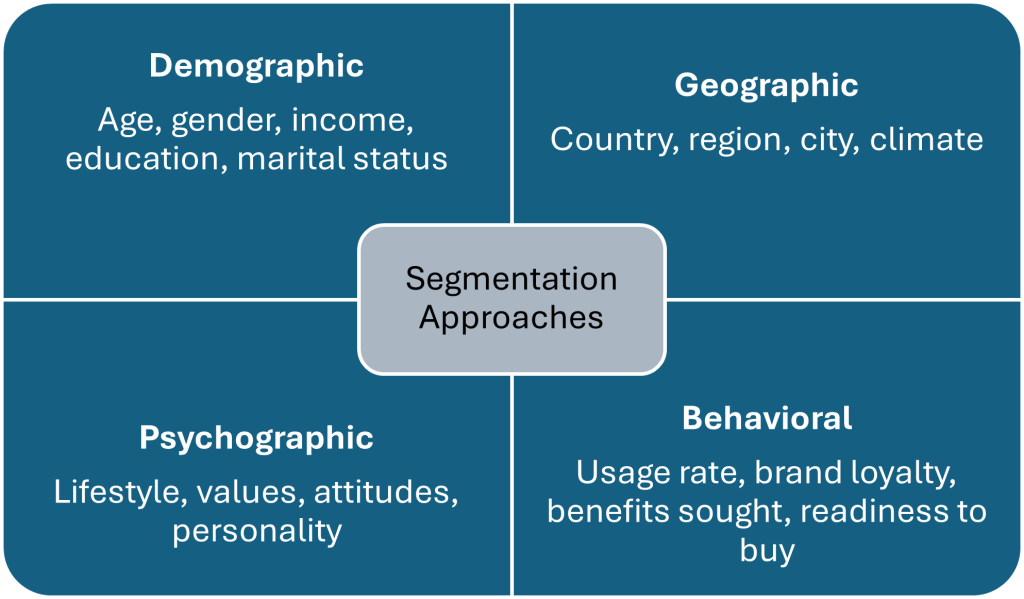Common Approaches to Market Segmentation
Segmentation starts by identifying all the potential buyers for your product: individuals with the need and the means to buy what you offer. In most cases, this represents a large universe of people or organizations that are similar in some ways but different in many other ways. Segmentation is a process that helps marketers narrow their focus on the most promising groups within that universe.
There is no single correct way to segment a market. Defining a target consumer base can be performed using a variety of segmentation methods. Several common methods are discussed below. Marketers may apply a combination of these methods to provide greater insight into their target market and the customers they want to serve. In fact, good marketers generally try out different methods and combinations to figure out what approach is most successful to help them achieve their goals. Because people and their needs change, effective approaches for segmenting a market can also evolve over time.
The following is a list of common market segmentation approaches:
- Geographic: countries, provinces, regions, cities, neighbourhoods, postal codes, climate etc.
- Demographic: age, gender, family size, income, occupation, education, religion, ethnicity, and nationality.
- Psychographic: lifestyle, personality, attitudes, and social class.
- Behavioral: user status, purchase occasion, loyalty, readiness to buy.
Note: In both consumer and business markets, marketers often segment based on buying roles—such as decision-makers, influencers, or end users—which fall under behavioral segmentation.

Geographic Segmentation

Geographic criteria—countries, provinces, regions, cities, neighbourhoods–define geographic market segments. Geography represents the oldest basis for segmentation. Regional differences in consumer tastes for products are well known, such as donairs in Halifax, steak in Calgary, or a higher number of laid-back, health-conscious vegetarians in Vancouver. Geographic segmentation suggests that in St. John’s NL you can sell raincoats, and rubber boots; in Toronto’s hot muggy summer, you can sell air conditioners; and in Fort McMurray Alberta, you can sell down winter coats and warm winter boots with January’s temperature averaging -20.7 °C.[1]
Geographic markets are easily identified, and large amounts of data are usually available. Many companies simply do not have the resources to expand beyond local or regional areas, so they must focus on one geographic segment only. There is very little waste in the marketing effort, in that the product and supporting activities such as advertising, physical distribution, and repair can all be directed at the customer. Further, geography provides a convenient organizational framework. Products, salespeople, and distribution networks can all be organized around a central, specific location.
The drawbacks of using a geographic basis for segmentation are also worth noting. There is always the possibility that consumer preferences aren’t dictated by location—other factors, such as ethnic origin or income, may be more important. 44% of the population of Metro Vancouver are Asian [2], their preferences and buying behaviours might differ from other ethnic demographic groups, each based on their own individual cultures rather than the location that they reside in. Another problem is that geographic areas can be defined as very large, regional locations. Members of a geographic segment may be too heterogeneous to qualify as a meaningful target market.
Demographic Segmentation
Demographics are statistical data that describe various characteristics of a population. Demographic segmentation consists of dividing the market into groups based on demographic variables such as age, gender, family size, income, occupation, education, religion, political opinions, ethnicity, and nationality. Demographic segmentation variables are among the most popular bases for segmenting customer groups because demographic data are plentiful and the customer wants and needs often link closely to these variables.

For example, the youth market (roughly ages five to thirteen) not only influences how their parents spend money but also how they make purchases of their own. Manufacturers of products such as toys, records, snack foods, and video games have designed promotional efforts directed at this group. “Tweens” are children between the ages of eight and twelve who are discovering what it means to be a consumer and are shaping the attitudes and brand perceptions they will carry with them as they grow up and gain more purchasing power. The elderly market (age sixty-five and over) has grown in importance for producers of products such as low-cost housing, cruises, hobbies, and health care.
Marketing to consumers in Vancouver’s multi-ethnic neighbourhoods may mean signs are not just displayed in English. Look carefully at the different signage on the Scotiabank building in Vancouver’s Chinatown.
| Pan-ethnic groups in Vancouver.[3]
Income is perhaps the most common demographic basis for segmenting a market because it indicates who can or cannot afford a particular product. It is quite reasonable, for example, to assume that individuals earning minimum wage could not easily purchase a $80,000 sports car. Income is particularly useful as a segmentation input as the price tag for a product increases. It can also be helpful in understanding certain types of buying behaviour, such as which income groups are most prone to use coupons. Similarly, other demographic characteristics can influence other types of consumer activities. Despite the apparent advantages of demographic segmentation (i.e., low cost and ease of implementation), uncertainty exists about its effectiveness. The method can be misused. For example, it might be said that the typical consumer of Thai food is under thirty-five years of age, has a college education, earns more than $10,000 a year, lives in a suburban fringe of a moderate-size urban community, and resides in the West. While these characteristics may describe a typical consumer of Thai food, they also describe many other consumers and may paint an overly broad or inaccurate portrait of a supposed "segment." When a segment is too broad, it loses its defining characteristics and there isn't much to differentiate the target segment from the general population. In this situation, the segmentation approach does not provide much useful guidance to help marketers make effective marketing choices. Psychographic SegmentationIn psychographic segmentation, consumers are divided according to common characteristics in their lifestyle, personality, attitudes, and social class. Evidence suggests that attitudes of prospective buyers toward certain products influence their subsequent purchase or nonpurchase of them. If persons with similar attitudes can be isolated, they represent an important psychological segment. Attitudes can be defined as predispositions to behave in certain ways in response to a given stimulus.[4] For market segmentation purposes, personality is defined as long-lasting characteristics and behaviours of a person that shape how they cope and respond to their environment. Consumption of particular products or brands relates to consumer personality. For example, risk-seeking individuals are attracted to extreme sports and travel, and extroverts tend to dress conspicuously. Social class segmentation identifies individuals based on a combination of socioeconomic such as education, occupation, income, family background, and attitudes related to these factors.
Lifestyle analysis generally begins by asking questions about the consumer's activities, interests, and opinions. If a woman earns $100,000–$150,000 per year as an executive, is married and has two children, what does she think of her roles as a professional, a wife, and a mother? How does she spend her spare time? To what groups does she belong? What does she read? How does she use electronic devices? What brands does she prefer, and why? AIO (activities, interests, opinions) inventories, as they are called, reveal vast amounts of information concerning attitudes toward product categories, brands within product categories, and user and non-user characteristics. Overall, psychographic segmentation tends to focus on how people spend their money; their patterns of work and leisure; their major interests; and their opinions of social and political issues, institutions, and themselves. While it can create intuitive groupings and useful insights into consumer behaviour, it can also take significant research and effort to inform a more complex and nuanced approach to defining market segments. Behavioral Segmentation
The most common type of behavioural segmentation is around user segments. In 1964, the market researcher Twedt made one of the earliest departures from demographic segmentation when he suggested that the heavy user, or frequent consumer, was an important basis for segmentation. He proposed that consumption of a product should be measured directly to determine usage levels, and that promotion should be aimed directly at the heavy user. This approach has since become very popular. Considerable research has been conducted on "heavy users" of a variety of products. The results suggest that finding other characteristics that correlate with usage rate often greatly enhances marketing efforts.[7] Other behavioural bases for market segmentation include the following:
Segmenting Business-to-Business MarketsAll of the segmentation approaches above apply to consumer markets. There are many similarities between consumer and business behaviour, and therefore similar segmentation bases and variables apply. Common business segmentation approaches include:
Combining Multiple Bases for SegmentationMarketers may find it most useful to combine different bases for segmentation in order to create a richer picture of their target market. For example, a "geo-cluster" approach combines demographic data with geographic data to create a more accurate profile of a specific consumer. Geographic data combined with behavioural data can point companies toward locations where customers are clustered who demonstrate behaviours that make them a good target for a company's product. Overlaying demographic data onto lifestyle or behavioural segments helps marketers understand more about their target customers and how to reach them effectively with the marketing mix. Any of these approaches may be the "right" approach for a given company and product set. It is also important for marketers to continually evaluate what's happening in their target market and to adjust their segmentation approach as customer attitudes, behaviours, and other market dynamics evolve. Creation notes: Chat GPT and Perplexity.AI were used to update and shorten text to include current examples and create a chart.
|
||
| Total Population | 2,607,010 | 100.0% |
| Total Visible Minority Population | 1,420,270 | 54.5% |
| South Asian | 369,290 | 14.2% |
| Chinese | 512,260 | 19.6% |
| Black | 41,180 | 1.6% |
| Filipino | 142,125 | 5.5% |
| Arab | 22,440 | 0.9% |
| Latin American | 51,500 | 2.0% |
| Southeast Asian | 56,815 | 2.2% |
| West Asian | 64,640 | 2.5% |
| Korean | 63,465 | 2.4% |
| Japanese | 31,195 | 1.2% |
| Visible minority, n.i.e. (not included elsewhere) | 14,750 | 0.6% |
| Multiple visible minorities | 50,600 | 1.9% |
| Not a visible minority | 1,186,740 | 45.5% |

 Lifestyle segmentation refers to the orientation that an individual or a group has toward consuming products, work, and play and can be defined as a pattern of attitudes, interests, and opinions held by a person. Lifestyle segmentation has become very popular with marketers, because of the availability of consumer data, measurement devices and instruments, and the intuitive categories that result from this process.
Lifestyle segmentation refers to the orientation that an individual or a group has toward consuming products, work, and play and can be defined as a pattern of attitudes, interests, and opinions held by a person. Lifestyle segmentation has become very popular with marketers, because of the availability of consumer data, measurement devices and instruments, and the intuitive categories that result from this process. Consumers are divided into groups according to common behaviours they share. Typically these behaviours link to their knowledge of, attitude toward, use of, or response to a product.
Consumers are divided into groups according to common behaviours they share. Typically these behaviours link to their knowledge of, attitude toward, use of, or response to a product.
